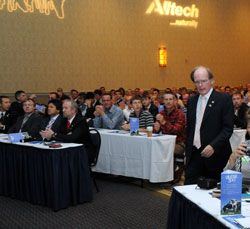 Providing the first remarks on the program for the Global Dairy 500 Conference was Dr. Pearse Lyons, founder and President, Alltech. The theme of his opening remarks was to answer the question, “Is there a future for dairy in these turbulent times?”
Providing the first remarks on the program for the Global Dairy 500 Conference was Dr. Pearse Lyons, founder and President, Alltech. The theme of his opening remarks was to answer the question, “Is there a future for dairy in these turbulent times?”
Dr. Lyons addressed the real challenges in the dairy business internationally. The Conference has attendees from all over the world and they all nodded in agreement as he made these opening remarks. He pointed out how volatile markets and prices are having a serious impact on the industry right now. So education and efficiency become extremely important and that’s part of the purpose of the Conference itself. So when it comes to the “crisis” Dr. Lyons challenged attendees to see it as a time of opportunity and character.
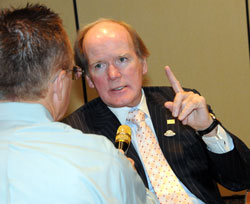 Looking to the future the key is efficiency and that will come about from the use of new technology. Besides efficiency he urged attendees to focus on more lactations per cow; quality in Production systems; more education; looking for Branding; traceability and to be conscious of the environment. I love his description of the dairy cow as a “walking fermenter.”
Looking to the future the key is efficiency and that will come about from the use of new technology. Besides efficiency he urged attendees to focus on more lactations per cow; quality in Production systems; more education; looking for Branding; traceability and to be conscious of the environment. I love his description of the dairy cow as a “walking fermenter.”
2009 Global Dairy 500 Conference Photo Album
I interviewed Dr. Lyons right after his presentation and you can listen to the interview below.
AgWired coverage of the Global Dairy 500 Conference is sponsored by  .
.

 Principal Research Scientist for Insect Resistance Dirk Benson talked about Syngenta’s global research capabilities during a symposium for agricultural reporters during the grand opening event. “In Europe, we have insecticide development, we have herbicide technology development, in the US we have formulation development on the crop protection side,” Dirk said. “On the seeds and traits side, we have capabilities for biotechnology in Research Triangle Park, North Carolina, we just opened a new site in Beijing, China to augment that. We do other seed research in Australia, we do some in Toulouse, France for our vegetable businesses, we do sugar beet work in Scandinavian countries.”
Principal Research Scientist for Insect Resistance Dirk Benson talked about Syngenta’s global research capabilities during a symposium for agricultural reporters during the grand opening event. “In Europe, we have insecticide development, we have herbicide technology development, in the US we have formulation development on the crop protection side,” Dirk said. “On the seeds and traits side, we have capabilities for biotechnology in Research Triangle Park, North Carolina, we just opened a new site in Beijing, China to augment that. We do other seed research in Australia, we do some in Toulouse, France for our vegetable businesses, we do sugar beet work in Scandinavian countries.”

 The man who is guiding the marketing efforts for
The man who is guiding the marketing efforts for  During a day in Fluidigm headquarters in South San Francisco I spoke with Howard about why he contacted us and what the company hopes to accomplish with our project. He says that agribusiness is a critical business for them. They’ve been working more with pure research companies up to this point but he says agricultural research comprises high volumes of samples and testing and that’s where they believe they offer the industry some significant advantages.
During a day in Fluidigm headquarters in South San Francisco I spoke with Howard about why he contacted us and what the company hopes to accomplish with our project. He says that agribusiness is a critical business for them. They’ve been working more with pure research companies up to this point but he says agricultural research comprises high volumes of samples and testing and that’s where they believe they offer the industry some significant advantages. 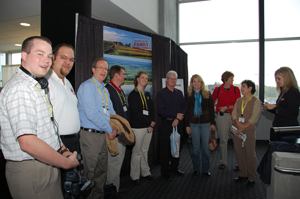 Some of the Twitter-heads attending World Dairy Expo met up for a Tweet Up on Thursday afternoon at the Media Room.
Some of the Twitter-heads attending World Dairy Expo met up for a Tweet Up on Thursday afternoon at the Media Room.  The
The 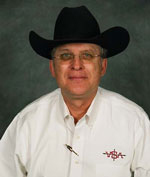 The
The 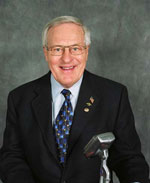 Evan Slack is founder and owner of the
Evan Slack is founder and owner of the  The
The  This week, Senators Barbara Boxer (D-Calif.) and John Kerry (D-Mass.) debuted the “
This week, Senators Barbara Boxer (D-Calif.) and John Kerry (D-Mass.) debuted the “ “America’s farmers and ranchers did not fare that well in the House-passed climate change bill and they fare even worse in the Senate bill,” said American Farm Bureau Federation President Bob Stallman. “There are few benefits and even greater costs to agriculture and the American public.”
“America’s farmers and ranchers did not fare that well in the House-passed climate change bill and they fare even worse in the Senate bill,” said American Farm Bureau Federation President Bob Stallman. “There are few benefits and even greater costs to agriculture and the American public.”